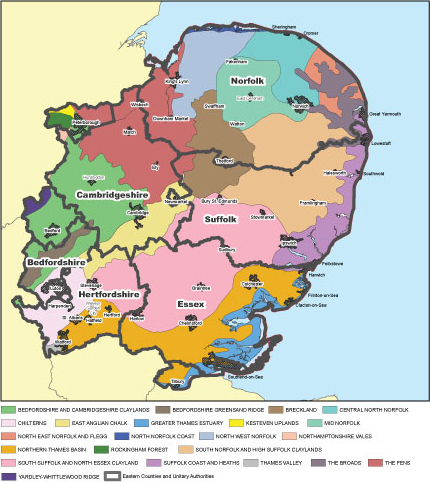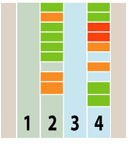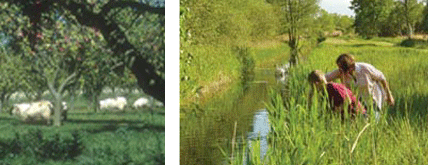| Securing habitats for our future |
A challenging task
The East of England is especially vulnerable to the likely effects of climate change:
• rising sea levels threatening more than just the coast
• growing incidence of seasonal flooding and inundation
• increasing risks of water shortage
These climate driven problems, coupled to unprecedented growth in housing stock and its need for attendant infrastructure and consequent pressures on water resources, means that, along with farming, many habitats will be vulnerable to these changes.
Thus the Forum has considered it vital that an overall plan covering all of the regional habitats is prepared:
Saving biodiversity
The East of England National Character areas

Targets
As the 2008 Delivery Plan already makes plain, the Forum is pursuing a comprehensive raft of objectives across the East of England to enable it to restore and improve existing habitats, and/or expand or create new habitats. To this end a set of targets had previously been developed to carry activity through to 2010.
New targets
The Forum is now committed to pursuing a new set of East of England targets for activity through to 2015. This thumbnail illustrates the main Habitat Targets table:
The rows in this table distinguish between the 11 discrete priority habitats (this list has been expanded - to compare it with the previous list click here and two grouped priority habitats. Each of these habitat rows divides into two component actions, viz.  restore/improve (columns '1' and '2') and expand/create (columns '3' and '4'). The targets for each of these component actions are specified in columns '1' and '3'. While their respective cumulative achievements are outlined in columns '2' and '4'. restore/improve (columns '1' and '2') and expand/create (columns '3' and '4'). The targets for each of these component actions are specified in columns '1' and '3'. While their respective cumulative achievements are outlined in columns '2' and '4'.
In the light of historic achievements to date, this table's achievement columns also utilises the 'traffic light' colour coding system in order to provide an indication of the restore/improve achievements to date ('2') and the likelihood of achieving the 2015 extend/create targets ('4').

It should be observed that, having attained a 'green' status, the totals secured noted in the tables below show that conservation activists' achievements have not been regarded as an excuse for stopping or slackening effort to secure as much habitat as possible.
For the majority of the habitats these revised targets have now been agreed as follows:
To download and/or print this 'wallchart' PDF of the table click here
Target Table Notes:
i. The figures above represent the gross habitat restored or created 'counted' at the point at which the key capital works has been completed. It is appreciated that it may take many years for that habitat to come into positive ecological condition.
ii. These figures represent the best estimates available from data provided by members of the Forum. It is appreciated that it is not possible collate comprehensive data on all habitats, but these figures indicate the achievements up to July 2010.
iii. It is appreciated that existing habitat may be lost or its condition impaired by external factors (such as sea level rise).
Where do we go from here?
It is hoped these targets will be used by:
County-level decision-makers
Local authorities (LAs)
Environmental organisations
Land owners/managers
Community groups
...in an effort to:
• influence East of England strategies
• encourage county councils/LAs to link biodiversity planning to community strategies
• guide environmental organisations and landowners
Regular reviews
These targets will continue to be regularly reviewed by the Forum and, from time to time, progress reports will be issued.
Back to top |


